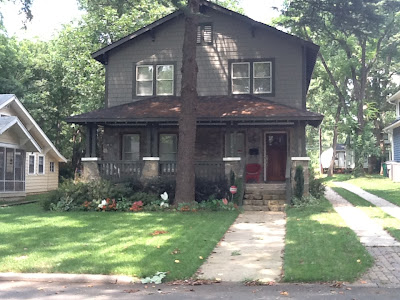 |
| Expanded and renovated house on Roslyn Avenue in Biddleville-Smallwood |
It’s happening almost within the shadows of the uptown towers – but I had little idea of the transformation until I got a short tour last Tuesday from neighborhood residents Tom Polito and Michael Doney. I surmise many other people in Charlotte are just as unaware.
Polito has lived since 2008 in a bungalow-style house built that year on Frazier Avenue, a street tucked between Interstate 77 and Johnson C. Smith University. Most of the houses on his block are new.
 |
| New construction, Rozzelles Ferry Road |
Polito introduced me to Michael Doney of 5 Points Realty, who’s been behind many of the upfits and new construction. Doney, originally from southwest Pennsylvania, lived for a time in Wesley Heights, another near-uptown neighborhood that has seen an influx of more affluent residents in the past 10 years. He now lives in Biddleville-Smallwood. Doney works with builders on renovations or to build and sell spec houses. He talked about the details: wood windows instead of vinyl, the way the porches are designed, the wide skirts on the steps out front of houses (see photo, right). He said he enjoys renovating older houses: “There's such cool old stuff.”
We drove down Rozzelles Ferry Road, then up through a 1940s-1950s-era neighborhood that looked like Chantilly’s separated-at-birth twin (Smallwood, said Doney) and into an area originally known as Roslyn Heights, which was built early in the 20th century. Now the whole area is generally referred to as Biddleville-Smallwood.
 |
| The duplex on Roslyn, before renovation |
“This has all happened since 2005-2006,” Doney said. “It’s quietly happening. People don’t know about it.”
Some things to keep in mind: Doney is a real estate guy. And Polito is thinking about selling. So they have a reason to be publicly complimentary of the area. But I saw what I saw. This area is truly being transformed. Young urban pioneers are moving in, people who, like Polito, like the look of an old-fashioned neighborhood but either can’t afford Elizabeth and Dilworth or who want houses that look old but have modern amenities.
Here’s an even more important thing to remember: This part of the city tells a story of a racial history more complex than you might realize. Although Johnson C. Smith University has been around since 1867 as a historically black school, some of its nearby neighborhoods were originally home to white residents. Others were originally home to black residents. Others were mixed. Tom Hanchett’s Sorting Out the New South City:Race Class and Urban Development in Charlotte 1875-1975 says Biddleville began as a village of housing for African Americans.
But Western Heights, the area where Polito’s new house is, started out in the 1890s as a mixed-race neighborhood. Wesley Heights and Seversville, on the other side of West Trade Street, were white neighborhoods, as was Roslyn Heights and later, Smallwood. Both were separated from the black neighborhood of Biddleville by only a narrow section of West Trade Street. (Doney pointed to how it was the back yards of the built-for-whites homes that backed up to Biddleville.) It wasn’t until the urban-renewal-block-busting, scared-of-integration era of the 1960s and 1970s that those areas became virtually all black.
Now, they’re transitioning again. Is there potential for tension across both racial and economic lines? Without a doubt. But if the residents and institutions in the area are able to work through the evolutions, and save what’s important to save, and with sensitivity to history, old-timers and newcomers, it will be worth those trumpets and fanfares.
